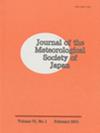以同化为目标的极化雷达正演算子的评价
IF 1.6
4区 地球科学
Q3 METEOROLOGY & ATMOSPHERIC SCIENCES
引用次数: 7
摘要
在极化雷达资料同化的准备工作中,有必要检验基于不同公式的正演算子的精度。为此,在c波段双极化雷达上,对四种关注暖雨条件的正演算子进行了相互比较和实际观测结果的比较。这些运算符相互考虑雷达波束展宽和气候波束弯曲。第一个算子基于散射振幅的拟合函数,假设模型得到的雨滴大小呈指数分布,从而推导出偏振参数。其他三个转换器根据测量的极化参数估计雨水的混合比。第二个转换器同时使用水平反射率(ZH)和差分反射率(ZDR),第三个转换器使用特定的差分相位(KDP),第四个转换器分别使用KDP和ZDR。与模型测量值的比较表明,第三种变换器的精度优于其他两种变换器。另一个实际观察的评估表明,第一个转换器的分数技能分数略高于其他三个。考虑到衰减效应,发现仅含KDP的拟合函数和算子最适合于c波段的数据同化。本文章由计算机程序翻译,如有差异,请以英文原文为准。
Evaluation of Forward Operators for Polarimetric Radars Aiming for Data Assimilation
In the preparation for polarimetric radar data assimilation, it is essential to examine the accuracy of forward operators based on different formulations. For this purpose, four forward operators that focus on warm rain conditions are compared both with each other and actual observations with respect to their performance for C-band dual polarimetric radars. These operators mutually consider radar beam broadening and climatological beam bending. The first operator derives polarimetric parameters assuming an exponential raindrop size distribution obtained by the models and is based on fitting functions against scattering amplitudes. The other three converters estimate the mixing ratio of rainwater from the measured polarimetric parameters. The second converter uses both the horizontal reflectivity (ZH) and the differential reflectivity (ZDR), the third uses the specific differential phase (KDP), and the fourth uses both KDP and ZDR, respectively. Comparisons with modeled measurements show that the accuracy of the third converter is superior to the other two. Another evaluation with actual observations shows that the first converter has slightly higher fractions skill scores than the other three. Considering the attenuation effect, the fitting function and the operator only with KDP are found to be the most suitable for data assimilation at C-band.
求助全文
通过发布文献求助,成功后即可免费获取论文全文。
去求助
来源期刊
CiteScore
6.70
自引率
16.10%
发文量
56
审稿时长
3 months
期刊介绍:
JMSJ publishes Articles and Notes and Correspondence that report novel scientific discoveries or technical developments that advance understanding in meteorology and related sciences. The journal’s broad scope includes meteorological observations, modeling, data assimilation, analyses, global and regional climate research, satellite remote sensing, chemistry and transport, and dynamic meteorology including geophysical fluid dynamics. In particular, JMSJ welcomes papers related to Asian monsoons, climate and mesoscale models, and numerical weather forecasts. Insightful and well-structured original Review Articles that describe the advances and challenges in meteorology and related sciences are also welcome.

 求助内容:
求助内容: 应助结果提醒方式:
应助结果提醒方式:


